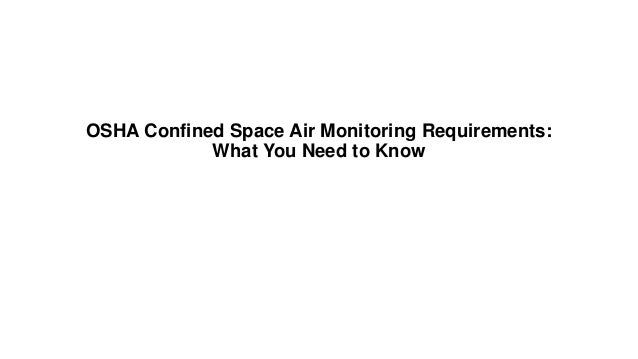
OSHA Confined Space Air Monitoring Requirements.pdf
- 1. OSHA Confined Space Air Monitoring Requirements: What You Need to Know
- 3. How much air do you need in your confined space? The answer to this question depends on a variety of factors, but OSHA has some requirements about how you monitor the air quality in your confined spaces, and that process starts with knowing what your acceptable levels are and what action to take when they’re not met. Here’s what you need to know about the Osha Confined Space Air Monitoring Requirements, including how it affects workers in non-permit required spaces.
- 4. A Confined Space Is Defined As A confined space is an area that is not designed for continuous human occupancy and has limited or restricted means for entry or exit. A confined space gas limit is the maximum concentration of a hazardous gas that is considered safe for workers to be exposed to. The OSHA confined space standard establishes requirements for employers to ensure the safety of workers who enter confined spaces. Employers must identify and evaluate the hazards present in the confined space, develop and implement a safety plan, and provide training to workers on the hazards and safety procedures. In addition, an employer must make sure that workers use required personal protective equipment and take appropriate precautions for potential hazards. OSHA confined space gas limits also require employers to develop and follow procedures for monitoring atmospheric conditions in a confined space at least once every 15 minutes during entry and reentry, as well as when work is ongoing inside. These air monitoring requirements are specified in 29 CFR 1910.146(d)(2). There are three types of confined spaces that employers must evaluate in order to develop a safe entry program: permit-required confined spaces, permit-required confined spaces with atmospheric hazards, and non-permit required confined spaces. The first two categories have specific entry procedures that differ from those used for non-permit required confined spaces.
- 5. The Requirements For Monitoring Air In A Confined Space • If you’re working in a confined space, you need to be aware of the air quality. The Occupational Safety and Health Administration (OSHA) has set requirements for monitoring the air in a confined space. Here’s what you need to know about the OSHA confined space air monitoring requirements. • There are two types of gas limits for confined spaces – An upper limit and a lower limit. In order to determine which gas is present in excess, the lower limit must be greater than or equal to the upper limit. • Osha confined space standard dictates that there should be continuous monitoring when someone is inside a confined space with an atmospheric hazard. However, if you are not measuring oxygen levels while inside the tight enclosure, you might miss that toxic substance like carbon monoxide or methane which are both deadly gases at high concentrations. • When someone is inside a confined space, they must be provided with an atmosphere that will not expose them to acute or chronic health effects. That means that no harmful or toxic substance like carbon monoxide, methane, and hydrogen sulfide can build up in your confined space. • One way to determine if you are working in a confined space with a harmful atmosphere is by monitoring oxygen levels and carbon dioxide levels. Both gases are important for life, but excess amounts of either one can be dangerous.
- 6. READ: 5 Confined Space Ventilation Requirements You Should Never Ignore Permissible Exposure Limits (PELs) The Occupational Safety and Health Administration (OSHA) requires that employers monitor the air in confined spaces for certain hazardous gases and vapors. The permissible exposure limits (PELs) for these gases and vapors are set by OSHA. If the concentration of any of these gases or vapors in the air exceeds the PEL, OSHA requires that the employer take steps to reduce the concentration to below the PEL. If, after taking these steps, there is still a violation of the PELs, OSHA requires that either an employee not work in that confined space or that an oxygen monitor be used. The employee using an oxygen monitor must be trained and certified in its use by a competent person. Some hazards may require additional testing or monitoring beyond those specified in OSHA standards for confined spaces. For example, if explosive atmospheres are a possibility, use of explosives detection equipment is required.
- 7. Key Factors Influencing Entry Into A Confined Space Key factors influencing entry into a confined space include: 1. The size of the space 2. The type of atmosphere inside the space 3. The amount of time that you will be spending in the space 4. Whether or not there is an oxygen-deficient atmosphere present 5. If there are any harmful gas concentrations present 6. Whether or not you have a self-contained breathing apparatus (SCBA) available 7. Whether or not anyone else is also entering the confined space with you 8. How much experience and training you have had working in confined spaces, etc. 9. What you plan on doing while inside the space (a job task vs just looking around). 10. Whether or not others can help if something goes wrong while you’re in the space 11. Are there other safety precautions taken to limit exposure to hazardous materials? 12. Does your company provide guidance on how long someone should spend in a confined space? 13. Is it a risk assessment (RA) or a permit-required confined space (permit space)? Etc. Continue Reading